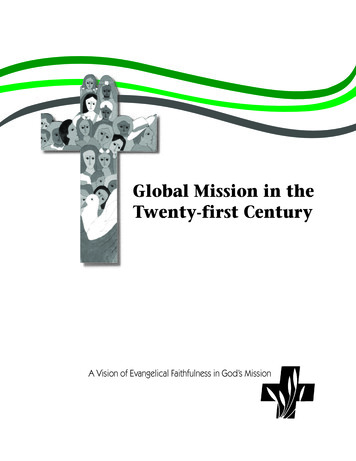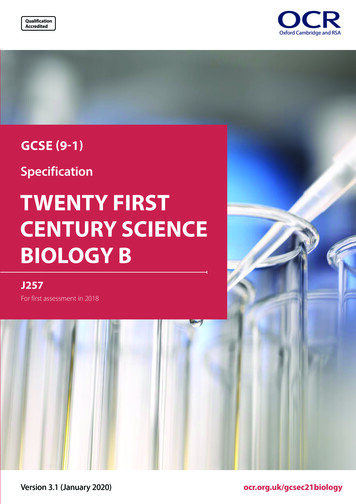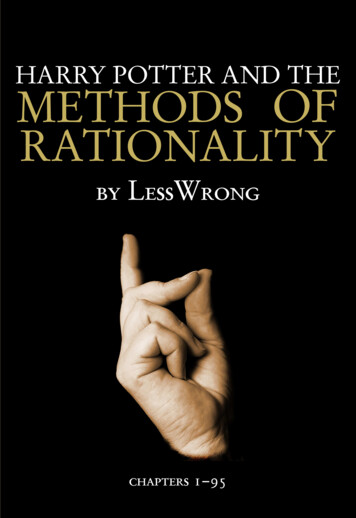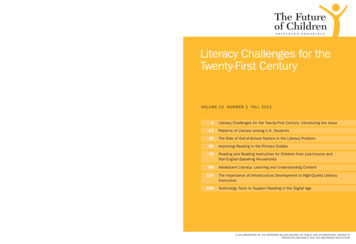
Transcription
Global Mission in theTwenty-first CenturyA Vision of Evangelical Faithfulness in God’s MissionEvangelical Lutheran Church in America, Division for Global Mission
ContentsfoeTablIntroduction . 3I. Accompaniment: The Missiological Vision . 5A. Background . 51. The Concept . 52. The Use of the Planning Document . 6B. Missiological Statement: The Mission of the Triune God . 71. God’s Mission in Creation . 72. God’s Mission in and Through Jesus Christ . 73. God’s Mission Through the Church . 84. The Nature of God’s Mission . 9C. Accompaniment in God’s Mission: A New Paradigm for the 21st Century . 121. The Accompaniment Model . 122. The Challenge of the 21st Century . 133. Examining the Past and Present Global Mission Context. 144. Participation of ELCA Constituency . 19II. Global Context . 21A. Global Mission Trends . 211. Religious Pluralism . 212. Globalization of the Market Economy . 213. Exploitation of Women and Children . 224. Ethnic Identity and Resurgent Fundamentalism . 225. Religious Demographic Shifts . 226. Decentralization . 22B. Companion Churches . 231. Companion Churches as Sending Agencies . 232. Leadership Development . 233. Changing Role of Missionaries . 234. A Wholistic Approach to Mission . 231
God’s Mission in the 21st CenturyIII. Directions for the Church into the 21st Century . 24A. DGM Planning Documents. 241. Long Range Goals . 242. Commitments . 243. Priorities . 25B. Goals and Program Objectives . 251. Goal I - Program Objectives . 252. Goal II - Program Objectives . 263. Goal III - Program Objectives . 274. Goal IV - Program Objectives . 28C. Criteria of Accompaniment: Twelve Signposts . 291. Witness in Word and Deed . 292. Witness Under the Cross . 293. Interfaith Witness and Dialogue . 304. Ecumenical Approach . 305. Wholistic Approach . 316. Justice, Peace and Integrity of Creation . 317. South-South Programs . 328. Racial Diversity and Gender Equity . 329. Transparency in Communication and Finance . 3310. Shared Decision Making . 3311. Diversity of Gifts . 3412. Contextualization . 34D. Ongoing Use and Evaluation of Strategy . 35AppendicesAppendix I The Preparation of Global Mission 21 . 36Appendix II The Programs of the DGM . 37Footnotes . 392
CTIONUDOIN T Rwo primary considerations prompt the Division forGlobal Mission (DGM) to rethink a strategic planappropriate for global mission in the twenty-firstcentury: 1) the nature of God’s mission in the world, and2) the nature of the Evangelical Lutheran Church inAmerica (ELCA).TAs the author of life, God continually works to redeem theworld. God’s work in history leaves global footprints.Global mission is largely the story of the emergence of newchurches as the result of God’s mission. A church inmission continually re-examines the global context of God’smission with respect for all other expressions of God’schurch. The surprises occasioned by God’s mission lead thechurch to search for global signs of emerging trends withinitself and God’s world.Each Christian community has its own peculiar characterand vitality, shaped by its context. The ELCA, like all otherexpressions of the church, has special gifts. In reviewing itspast and present planning, strategies and programs, itsearches for the best gifts it has to contribute to the missionof the global church. In terms of global mission, the ELCAprays that its gifts intersect with the most pressing needs ofcompanion churches and the global context, and is open toreceiving the gifts of its companions in order to meet itsown most pressing needs. Together they may selectivelycombine their gifts for mission in a new area where nochurch exists.This vision for mission is shaped by three major factors:1) a theology for mission,2) the global context, and3) an inventory of the ELCA’s gifts and needs.This strategic planning process has reviewed the DGM’spast planning documents, examined the global contextfrom many perspectives and now recommends how theELCA can best use its gifts and receive those of others atthis time. Building on the DGM’s foundational planningdocuments of the last decade, this planning documentconcentrates on a concept called accompaniment as apromising vision for invigorating global mission at thebeginning of the new century.3
God’s Mission in the 21st Century4
I. Accompaniment:The Missiological VisionA.Background1. The ConceptThe concept of accompaniment is becoming a central themein an emerging vision of global mission. Its promise lies ininviting the ELCA to take seriously the contributions ofother expressions of the global church. The interactionof companion churches around the world reflects theirevaluation of and attitudes about their relationships withother Christians in both North and South.1 Their evaluations of past and present interactions offer valuable insightsinto how the ELCA can learn to participate effectively inGod’s mission together with other Christians.The lessons the ELCA learned in bilateral relationshipsinternationally and from discussions within the LWFcommunion of churches2 became associated with the wordaccompaniment via an action taken by the DGM board in1995. In that year the board of the DGM called for a reevaluation of DGM’s participation in Latin America,resulting in the document, “Mission Strategy for LatinAmerica.” The keystone of the strategy is the concept of a“pastoral accompaniment” (acompanimento pastoral) whichis described along with its implications for the ELCA andthe Latin American churches.We understand accompaniment as walking together in asolidarity that practices interdependence and mutuality.The basis for this accompaniment, or what the NewTestament calls koinonia, is found in the God-humanrelationship in which God accompanies us in JesusChrist through the Holy Spirit.This pastoral accompaniment calls upon the ELCA andthe Latin American Lutheran churches to:1. Affirm the diversity of viewpoints that exists amongour sister churches;2. Encourage our churches to question and analyzeamong ourselves the priorities and practices of ourchurches;3. Be transparent and engage in honest and sinceredialogue;4. Move beyond the traditional relationships of thepast between North and South and South to South;5. Involve the churches and agencies affected by adecision in decision-making processes; and6. Acknowledge that the churches in both the Southand the North will be in solidarity with one anotherin their weaknesses, struggles and mission.3Many terms have traditionally been used to describe therelationship between and among companion churches. Aspolitical colonialism declined after the Second World War,the word “partnership” was used to describe the relationshipbetween the former sending churches and the emergentinternational churches. Some churches prefer this term andwill continue to use it because it best expresses their conceptof cooperation in God’s mission. The implications of thisterm have come under scrutiny by other churches and oftenbeen found wanting.4 Critics note that the term “partnership” may mask an unequal yoking of a supposedly powerful giver and a weaker receiver; i.e., it preserves the ecclesiastical counterpart of colonialism.The implications which emerge from the concept ofaccompaniment have global relevance and call for fundamental change in the implementation of global mission5
God’s Mission in the 21st Centurystrategies and programs. If the strategic planning withwhich the ELCA-DGM approaches the twenty-first centurydoes nothing more than help it to understand accompaniment and lead to the implementation of the attributes ofcompanionship in relationships between the ELCA andcompanion churches, it will have served its purpose.Accompaniment is more than an exclusive contract betweentwo or more companion churches. It is a walking togetherin Jesus Christ of two or more churches in companionshipand in service in God’s mission.5 In the walking together onthe road to Emmaus, the Lord reveals himself to his companions. While walking together, each of the two disciples’and Jesus’ stories become interlocked. Their three storiesbecome intertwined. As the stories come together, God’splan in Jesus’ resurrection becomes clearer. A new community, the church, begins to emerge in Jerusalem. In sharing ameal the companions recognize the presence of Jesus withthem.Accompaniment emphasizes relationship before resources.Development of programs and allocation of resources flowfrom how companions relate, rather than vice versa.Accompaniment is valued for its own sake as well as for itsresults. It is open-ended with no foregone conclusions. Thecompanions learn together in the journey. Accompanimentbinds companions more closely to their Lord and furtherinforms their mission.A primary reality of accompaniment is the mutual respect ofthe companions. The conversation is no longer between agiver and a receiver but between two churches, each ofwhich has gifts to give and to receive. The difference inkinds of gifts is not prioritized. Mutual respect also appliesto regions. In accompaniment each church has the primaryresponsibility for mission in its area. In conversationsbetween the churches, each will describe its gifts for outreach in its own country. A fruitful outcome of the conversation is the discovery of the outside church’s gifts that mayassist in mission in a church’s own country.6In hearing the ELCA’s perspective that a church has primaryresponsibility for mission in its area, some churches mayquestion if their associations with current North Americanor European companion churches are being diminished.On the contrary, accompaniment is a means toward establishing stronger community among churches in relationshipwith their Lord.2. The Use of the Planning DocumentGlobal Mission 21 is a planning document of the ELCA.Most of its content comes from two sources: the history ofthe interaction between DGM and its companion churchesand the current lessons learned from the churches, agenciesand individuals with whom the ELCA is in conversation. Itpoints to those issues which the ELCA intends to concentrate on in mission at the beginning of the 21st century, asopposed to providing a comprehensive assessment of majorglobal mission issues. As a document intended to promotestewardship of resources, it intends to focus ELCA-DGMefforts in mission by selecting those issues which the ELCAis best equipped to address.This planning document has a variety of audiences, anddifferent portions of the document are intended for specificgroups: A working document for the DGM board as it designsand evaluates policy, and for staff and missionarypersonnel as they implement programs. A brief summary document for companion churchesand others who want a condensed description ofwhat the DGM is and how it does its work. A foundational document for preparation of Biblestudies and education for mission study materialsamong congregations and synods of the ELCA. A foundational document for theological andmissiological discussions in ELCA seminaries andschools.
Accompaniment: The Missiological VisionB. Missiological Statement: The Missionof the Triune God–Good News of LifeThe Triune God is a missionary God. As Father, Son andHoly Spirit, the Triune God creates, sustains, liberates, andrestores life in all creation. Scripture uses many metaphorsto describe the life-saving work of God in Jesus Christ:forgiveness, justification, reconciliation, liberation, sanctification, seeking the lost, adoption, ransom, expiation,salvation, new creation, and the coming of the Kingdom ofGod. The Book of Acts uses new language and metaphors asChristian mission moves from a Hebrew context to Greekand Roman cultural contexts. In cross-cultural mission,Christian witness finds metaphors that communicate mostmeaningfully within each new context. This paper focusesprimarily on God, the Giver of Life, as a meaningfulmetaphor for speaking the gospel in today’s global context.As we reflect on the relational nature of the Trinity and themutuality and reciprocity expressed in the community ofFather, Son and Holy Spirit, we find also that the mission ofthe Trinity is relational and expressed in community. Lifecreated and sustained by God is life in relationship. Interms of God’s missionary purpose, life is a state of wellbeing where each member of creation lives in right relationship with God, itself, and the whole creation.As Christians baptized in the name of the Father, the Sonand the Holy Spirit, we are incorporated into the family ofGod, and called and sent to be fellow workers in the lifegiving mission of the Triune God. Through God’s presencein the Word and the sacramental meal, we are nurtured inour faith and empowered for our missionary vocation inthe world.1. God’s Mission in CreationGod is on a mission to create and sustain life. The earlybiblical testimony in Genesis pictures the wind6 of Godblowing back the watery chaos and creating all of life. WhenGod breathes into earthen clay, the human creature comesto life. When God speaks, all creation is called into beingand called good. God accompanies the creation by beingpresent and in relationship with it, even when it is marredby sin and rebellion.Biblical history witnesses to the life-creating God who ispresent and active today. In the beginning and also today,God is present and continues to create life throughout theuniverse. Each baby that is born and each galaxy thatevolves bear testimony to God’s mission of life. God’smission is a continual creation of life through the power ofthe Holy Spirit.Humanity, male and female, is created in the image of God(Genesis 1:27) and is intended to live in community with Godand one another and in relationship to the whole creation.Each human being is of infinite worth and is to be honoredand respected as a bearer of the image of God. As bearers ofthis image, humanity is called to participate in God’screative and life-sustaining work. Every human heart bearsthe imprint of the law and wisdom of God (Romans 2:15)and all people are called to protect and preserve creation.God’s life-endowed creation is marred and destroyed byhuman irresponsibility and rebelliousness, and by thepowers of sin, evil, and death. Yet God continues to accompany, renew and liberate the creation that groans in itsbondage to decay. God reclaims us for life-giving relationships with God, each other, and all creation. God works inthe hearts of all people, preparing them for the Good Newsof God’s re-creation of life in Jesus Christ who “is the imageof the invisible God, the firstborn of all creation”(Colossians:1.15).2. God’s Mission in and Through JesusGod is on an incarnational mission to heal, restore, redeem,and liberate life. God as life-giving creator is incarnate inJesus of Nazareth who is born of Mary and the Holy Spirit’spower. When Jesus is baptized by John, the Holy Spiritdescends on him and a voice from heaven speaks, “You aremy Son, the Beloved; with you I am well pleased” (Mark1:11). In Jesus “the whole fullness of deity dwells bodily”(Colossians 2:15). Jesus is God’s accompanying nature madevisible in a man.Jesus, the embodiment of God, announces his mission inNazareth by quoting the prophet Isaiah: “The Spirit of theLord is upon me, because he has anointed me to bring goodnews to the poor. He has sent me to proclaim release to the7
God’s Mission in the 21st Centurycaptives and recovery of sight to the blind, to let theoppressed go free, to proclaim the year of the Lord’s favor”(Luke 4:18–19). Jesus’ ministry is God’s mission to overcomethe enemies of life and to restore life as God intended it.Wherever the powers of evil and death have diminished ordestroyed God’s intended life for all creation, God in Jesusis on a life-giving mission of love, bringing food for thehungry, water for the thirsty, forgiveness for sinners, selfworth for the marginalized, good news for the poor, peacefor the conflicted and war-ravaged, intervention for theoutcast and oppressed, deliverance for those enslaved byevil powers, and life for the dead and dying. Jesus said hecame that we “might have life, and have it abundantly”(John 10:10).Jesus’ ministry is a radical struggle for life. This puts him incontinual conflict with those who would limit and destroylife. Jesus ultimately expresses God’s vulnerable love for allhumanity in his willingness to die in this struggle. Finally,he is put to an unjust, humiliating and yet redemptive deathon a cross.The resurrection of Jesus is God’s reaffirmation of life and asign of hope in a world marked by sin and death. It declaresthat God’s salvation, the restoration of life for all people andall creation, is rooted in God’s compassionate and vulnerable love embodied in Jesus’ ministry and death. For thosewho die seeking and trusting in the God who was incarnatein Jesus of Nazareth, his resurrection is the promise of lifein the eternal presence of the living God. The proclamationof Jesus’ resurrection calls forth faith in God “who gives lifeto the dead and calls into existence the things that do notexist” (Romans 4:17).The resurrection of Jesus is also God’s affirmation of Jesus’way of mission in the world, a way of servanthood andcommitment to struggle to bring life for others. Jesus callshis followers to mission in his way: “If any want to becomemy followers, let them deny themselves and take up theircross and follow me. For those who want to save their lifewill lose it, and those who lose their life for my sake, and forthe sake of the gospel, will save it” (Mark 8:34b–35). Jesuspromises to meet us as a living presence today in those whosuffer hunger, thirst, nakedness, sickness, and imprisonment(Matthew 25:35–36).8Before leaving his disciples, Jesus promises to send the HolySpirit who will continue God’s worldwide mission in andthrough us. “. . . you will receive power when the HolySpirit has come upon you; and you will be my witnesses inJerusalem, in all Judea and Samaria, and to the ends of theearth” (Acts 1:8).3. God’s Mission by the Holy SpiritIn the Holy Spirit, God is on a mission to create a new lifegiving community. When the promised Holy Spirit fallson the Pentecost gathering of disciples in Jerusalem, theChristian church is created and its mission is launched(Acts 2) . The message of Jesus is heard and understood inmany languages, a sign that God’s mission is intended toreach people of all nations. From the beginning, God’smission through the Holy Spirit is accompanied by preaching, healing, baptizing, and teaching the new disciples to liveby faith and trust in the grace of God. As new members areincorporated into the church, the Body of Christ, newcommunities are formed to nurture new believers andequip them for service and witness.The Holy Spirit accompanies the new community withpower, endowing it with a variety of gifts, all of which are tobe dedicated to the mutual building up of the Body andto the equipping of the members for their ministries(I Corinthians 12). The members bear the fruits of the Spirit(love, joy, peace, patience, kindness, generosity, faithfulness,gentleness, self-control), living a life of discipleship guidedby the Spirit (Galatians 5:22–25).The Body of Christ lives in a rhythm of gathering andsending. The church gathers for nurture and equipping.Thus empowered, the members of the Body are sent out tobe God’s incarnate mission of life in the world. In thisrespect, all Christians are ministers, called and equipped toembody God’s life-giving word and deed in their daily lives.All Christians are called into ministry in their daily lives.However, the church calls some to the ministry of leadership and equipping of the other members. As a newcommunity, the Church receives God’s life through Wordand Sacrament, is empowered by the Holy Spirit, and livesas God’s sacrament of grace in the words and deeds of lifein the world.
Accompaniment: The Missiological Vision4. The Nature of God’s MissionAs individuals and as a church, we are called to participatein God’s mission of life locally and globally. As the Evangelical Lutheran Church in America, we respond together asone community of faith, most often by accompanying otherChristian communities in God’s mission. Together we sendand receive missionaries who witness to God’s good news,exchange gifts that support the mission, bear one another’sburdens, and advocate for God’s righteousness and justicein the world. Together we develop relationships of witnesswith those who do not acknowledge faith in Jesus Christ.The mission of God that we share as a church has thefollowing characteristics:a. EvangelicalEvangelical, derived from the Greek word meaning “goodnews,” identifies the Christian message as God’s good newsin Jesus Christ. The Lutheran Reformation primarilyidentified this good news (gospel) with God’s justificationof sinners by grace through faith in Christ apart from worksof the law. In the medieval culture marked by the experience of guilt in the presence of the terrifying justice of God,and in a European church that offered a multitude ofecclesiastical activities whereby God could be appeased,Martin Luther proclaimed that all human efforts werefruitless and unnecessary. God in Christ offers forgivenessand justification as a free gift of God’s grace. This was andstill is good news for frightened, guilty sinners. This is acourtroom metaphor where the guilty hear life-giving goodnews: the pronouncement of acquittal. The New Testament uses a variety of metaphors to communicate the goodnews of Jesus Christ: justification, forgiveness, kingdom ofGod, liberation, finding the lost, sanctification, acceptingthe outcasts, and resurrection. This good news is themotivating power of the mission of the church and iscontinually being translated into new images and languageas the mission moves out from Jerusalem to the ends of theearth.Today’s global church also perceives that the biblical goodnews should be proclaimed in a variety of metaphors inorder to communicate effectively God’s good news of life inJesus Christ. Among the poor, marginalized, and oppressedpeoples of the world, the gospel announces that sufferingand pain are not the will of God but are shared by God andintended to be overcome. When people experience alienation or feel God’s absence or judgment, God’s good newspromises that God is with and for them in their sufferingand humiliation. Good news is the resurrection hope in thepresence of death, the affirmation of the value of human lifein the face of economic materialism, the conviction ofpurpose and meaning in a secularist wasteland, the promiseof the Holy Spirit’s liberation for the demon-possessed, andthe hope of transformation for those who seemingly havesold out to the gods of violence and war.b. DisciplingThe church in mission is called to make disciples, baptizingand teaching them in the way of Jesus (Matthew 28:17–20).New believers are baptized into the mission of Christ. Theyare trained and equipped for their missionary vocation, toshare their faith with others. They are sustained by regularproclamation of the Word of God and the gift of theEucharist. They are taught to pray and to study the scriptures. Disciples with leadership potential are identified andprepared to take up leadership responsibilities in thecommunity.The discipling task implies the birthing of communities offaith to sustain the new disciples. As new faith communitiesform, the existing church is called to nurture their development and sustain them in the faith. The discipling taskincludes building churches with theological andmissiological purpose, indigenous expression of theChristian faith and life, trained leadership, accountability ofmembers and leaders, and structures to adequately nurturethe faith and extend the mission of God’s life in the world.c. ContextualGod’s creating word became flesh in Jesus. The word of Godthat brought creation into being is the same word thatbecame embodied in Jesus. God is incarnate in the specifichuman person of Jesus of Nazareth in order that the peopleof Israel might experience this saving, transforming powerof God. It is significant that the New Testament is written inGreek rather than Aramaic, the language in which Jesuscarried out his mission. It testifies to the power of God’s9
God’s Mission in the 21st Centurymission to adapt to new people, cultures and situations inorder that God’s good news might be known. The history ofthe Christian church is a history of the gospel taking root innew contexts, new geographical locations.The mission of God continues to transcend familiarcultural forms and theological formulations in order thatJesus Christ, as the creative Word of God, might be atransforming power in every cultural context of the globe.Workers in mission are committed to the contextualizationof the gospel and the indigenization of the church in eachcontext and each culture.d. WholisticThe mission of God is a ministry dedicated to transformingall reality. Biblical visions of God’s saving power arewholistic visions. All forms of evil (alienation, exploitation,oppression, destruction, and death) are to be overcome sothat life may flourish within God’s creation. The land willbe fruitful, the wolf and the lamb will eat together, everyhuman family will dwell securely within its own home, andGod will be known as the source and presence of loveand life.Jesus’ ministry reflects this wholistic vision as the sick arehealed, lepers are cleansed, the demon-possessed areliberated, the marginalized
giver and a receiver but between two churches, each of which has gifts to give and to receive. The difference in kinds of gifts is not prioritized. Mutual respect also applies to regions. In accompaniment each church has the primary responsibility for mission in its area. In conversations between the churches, each will describe its gifts for out-











